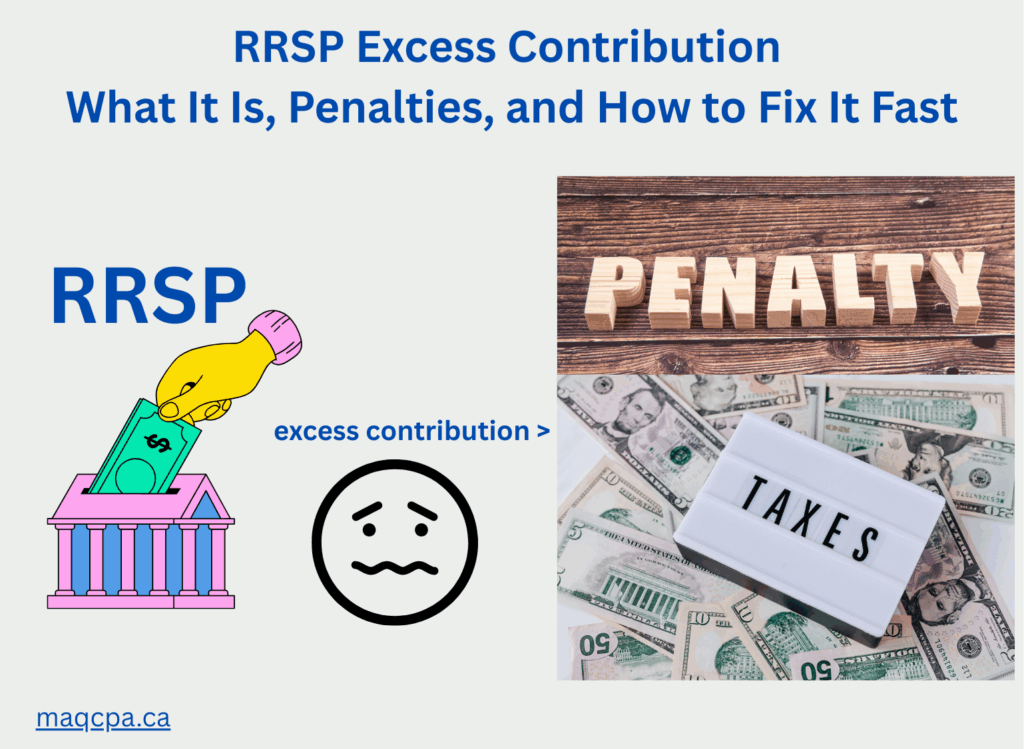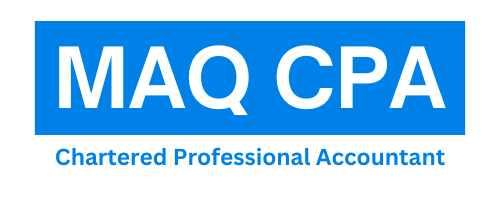An RRSP excess contribution can sneak up on even the most diligent saver—especially if you contribute at multiple institutions, use a group RRSP through work, or top up during the first 60 days of the year. This guide explains what counts as an excess contribution, how the 1% per-month penalty works, exact steps to fix it, which forms apply, and the tools that keep you safe going forward. We’ve written it for self-employed professionals, employees, and incorporated owners across Canada.

Why This Matters
Excess contributions trigger a monthly penalty tax and can also lead to late-filing penalties if you miss the correction deadlines. Fixing it quickly protects your refund, reduces interest, and keeps your retirement plan on track. The good news: with the right steps—and, in some cases, a waiver request—you can often limit or eliminate most of the damage.
RRSP Room 101 (Know Your Limit Before You Contribute)
- How your room is calculated: Your RRSP deduction limit equals 18% of last year’s earned income up to the annual RRSP dollar limit (2024: $31,560; 2025: $32,490), minus your pension adjustment (PA), plus any pension adjustment reversal (PAR), minus any net past service pension adjustment (PSPA), plus unused room carried forward from prior years.
- Where to find your limit: Your Notice of Assessment (NOA), T1028 – Your RRSP Information, or CRA My Account.
- Spousal RRSP reminder: Contributions to a spousal RRSP use your room, not your spouse’s.
Excess Contribution vs. Unused Contributions (Don’t Mix Them Up)
- Unused contributions: Money you’ve already put into an RRSP but didn’t deduct yet. These are not a problem by themselves.
- Excess contributions: When your unused contributions + current-year contributions are more than your deduction limit plus the $2,000 lifetime cushion (available once you’ve been age 18 or older). That overage triggers the 1% penalty per month until fixed.
- Tip: The $2,000 cushion prevents small slip-ups from causing the monthly tax, but you cannot deduct that cushion unless you have available room in a later year.
The 6-Step Action Plan to Fix an RRSP Excess Contribution
Step 1 — Stop contributing immediately
Pause all automatic contributions (including group RRSP payroll deductions). Confirm your up-to-date room in CRA My Account.
Step 2 — Calculate the true excess
List every contribution (including those in the first 60 days of the year), the exact dates, and any withdrawals. Align them to calendar months; the penalty is calculated per month the excess exists.
Step 3 — Withdraw the excess (the right way)
- Preferred route (no withholding at source): File Form T3012A to CRA to get approval so you can withdraw the unused contributions without tax withheld at the time of withdrawal.
- If timing is tight: You can withdraw without T3012A; tax will be withheld at source. Later, use Form T746 to calculate the deduction for the refund of unused RRSP contributions, which offsets the income inclusion from the withdrawal.
Step 4 — File the excess-contribution return (if required)
If you went over the $2,000 cushion, complete T1-OVP – Individual Tax Return for RRSP, PRPP and SPP Excess Contributions. It’s due 90 days after the end of the calendar year in which the excess existed (generally March 31). This return calculates the 1% per-month tax.
Step 5 — Consider asking CRA to waive/cancel the monthly tax
If the excess arose from a reasonable error and you’ve eliminated the excess quickly, you can request relief using RC2503 – Request for Waiver or Cancellation of Part X.1 Tax. Include a clear explanation and supporting documents.
Step 6 — Build guardrails for next year
Turn on room alerts, keep a contribution tracker, and coordinate with employers/financial institutions so total contributions never exceed your available room.
RRSP Excess Contribution — Summary Table (Scenarios, Solutions & Tools)
| # | Common Scenario | What’s Happening | Practical Solution (Clear Steps) | Helpful Tools (Examples) |
| 1 | First-60-days top-up + later payroll deductions | Early-year deposit + automatic group RRSP pushes you over your limit | Freeze payroll RRSP; compute monthly excess; withdraw the overage (T3012A if time; otherwise withdraw and use T746); file T1-OVP if over the $2,000 cushion | CRA My Account; employer HR/Payroll portal; T3012A/T746 |
| 2 | Multiple institutions, no central tracker | Two advisors contributing without seeing each other’s deposits | Build a consolidated contributions list by date; set a single auto-deposit; adjust down to available room | Bank downloads; spreadsheet tracker; calendar alerts |
| 3 | Misread NOA vs. advisor estimate | You relied on an estimate, not your official limit | Use NOA/T1028 in My Account; correct contributions; withdraw excess and document months | CRA My Account; T3012A or withdrawal + T746 |
| 4 | Big PA from new pension | Joining/expanding a pension plan slashed RRSP room mid-year | Get final PA from T4; recompute room; unwind the excess as above; consider RC2503 if truly a reasonable error | T4/PA; My Account; T3012A/T746; RC2503 |
| 5 | Spousal RRSP confusion | You contributed to spouse’s RRSP thinking it used spouse’s room | Remember: your room is used; compute excess; withdraw and correct reporting | Spousal plan statements; T3012A/T746 |
| 6 | Group RRSP mandatory deposits | Employer plan auto-contributes beyond your remaining room | Ask HR to cap or pause; correct past overage; attach plan documents if filing T1-OVP or RC2503 | HR portal; plan docs; T1-OVP; RC2503 |
| 7 | Counting principal residence HBP/LLP repayments as room | Repayments are not new room; over-contribute by mistake | Review Schedule 7; correct contributions; adjust future payroll deposits | Schedule 7; My Account; contribution tracker |
| 8 | FX timing on USD deposits | Exchange rate swings push CAD value over your limit | Track deposits in CAD by date; unwind the small excess quickly | Institution statements; FX memo; T3012A/T746 |
| 9 | Late discovery of prior-year excess | Excess sat for months, increasing 1% tax | Do the withdrawal now; complete T1-OVP; consider RC2503 with a clear timeline and proof | T1-OVP; RC2503; month-by-month schedule |
| 10 | Advisor changed pre-authorized amount | New amount ignored your pension contributions | Reset pre-auth to leave buffer; annual check each January; fix any overage quickly | Pre-authorized contribution settings; calendar alert |
Real-Life Examples – RRSP Excess Contribution
- Toronto engineer (group RRSP + first 60 days): In February, she contributed $8,000 at her bank, then forgot to reduce her group RRSP payroll deposits. By June, she had a $3,200 excess. She subsequently paused payroll contributions, requested a T3012A withdrawal for the exact overage, filed T1-OVP for months the excess existed, and submitted RC2503 explaining the timing error and immediate correction. Result: penalty exposure minimized, and payroll caps added to prevent recurrence.
- Mississauga couple (spousal plan confusion): He contributed $5,000 to his spouse’s RRSP assuming it used her room. It actually used his room and created a small excess. He prepared a precise contribution calendar, withdrew the overage (no-withholding route with T3012A), then used T746 to align income/deduction where needed. They now share a single tracker visible to both advisors.
- Scarborough professional with new pension: A physician joined a group pension mid-year, cutting RRSP room. Quarterly auto-contributions created an excess. He pulled the PA from the T4, recalculated room, withdrew the excess, filed T1-OVP, and supported a reasonable-error RC2503 request with contract documents showing the mid-year change. He now runs a January room check before setting the new year’s RRSP amount.
FAQs – RRSP Excess Contribution Canada
1) What exactly is an RRSP excess contribution?
It’s the portion of your RRSP, PRPP, or SPP contributions that exceeds your deduction limit plus the $2,000 cushion (available once you are 18 or older). That overage is subject to a 1% per-month tax for each month it remains in the plan.
2) What’s the deadline to file the RRSP excess-contribution return?
If you went over, you generally must file T1-OVP (and pay any 1% tax) within 90 days after the end of the calendar year in which the excess existed—typically March 31 of the following year.
3) How big is the penalty on excess RRSP contribution?
The tax is 1% per month on the amount above your $2,000 cushion. If you file T1-OVP late, late-filing penalties may apply in addition to arrears interest.
4) Can CRA waive the 1% tax on RRSP excess contribution?
Possibly. If the excess arose from a reasonable error and you acted quickly to remove it, you can request relief using RC2503. Provide a clear timeline, proof, and a plan to prevent recurrence.
5) How do I withdraw the excess RRSP correctly?
Option A: Ask your RRSP issuer to process a withdrawal with an approved T3012A so no tax is withheld at source.
Option B: If you can’t wait for approval, withdraw now (tax will be withheld) and use T746 to calculate the deduction that offsets the income inclusion from the withdrawal of unused contributions.
6) Do RRSP contributions in the first 60 days count toward last year or this year?
For deduction purposes, first-60-day contributions can be claimed on either the prior year or the current year. For excess-tax calculations, you must track the exact months the money was in the RRSP to compute any 1% tax accurately.
7) Does the $2,000 cushion for RRSP contribution mean I can always go $2,000 over?
It’s a lifetime buffer to prevent small mistakes from triggering the monthly tax. You cannot deduct that buffer until you have room. Treat it as an emergency margin, not a target.
8) What if my employer’s group RRSP is mandatory?
If mandatory deposits pushed you over, you still need to correct the excess. Keep the plan documents and dates; they help demonstrate reasonable error for a potential waiver request.
9) I contribute to a spousal RRSP—whose room is used?
Yours. Contributions you make to a spousal RRSP reduce your room, not your spouse’s. Misunderstanding this is a common cause of small excesses.
10) How can I prevent RRSP excess contribution from happening again?
Use a single contribution source where possible, set an annual cap with your employer or advisor, run a January room check in CRA My Account, and maintain a month-by-month contribution tracker shared with anyone who contributes on your behalf.
Consult a Tax Professional Toronto/Markham
An RRSP excess contribution is fixable—speed and documentation are everything.
Schedule a consultation for RRSP excess-contribution Review with MAQ CPA firm’s personal tax accountant Toronto/Scarborough. We’ll calculate the true excess, map the fastest correction path, prepare the right forms, and help you set up the guardrails so it never happens again.
Disclaimer
The information provided in this blog is for general informational purposes only and does not constitute professional accounting, tax, financial, or legal advice. While we strive to ensure the accuracy and timeliness of the content, the information may not apply to your specific situation or reflect the most current legislative changes. Readers are strongly advised to consult a qualified legal or tax professional before making any decisions based on the content of this blog. MAQ CPA and its representatives disclaim any liability for any loss or damage incurred as a result of reliance on any information provided herein.
